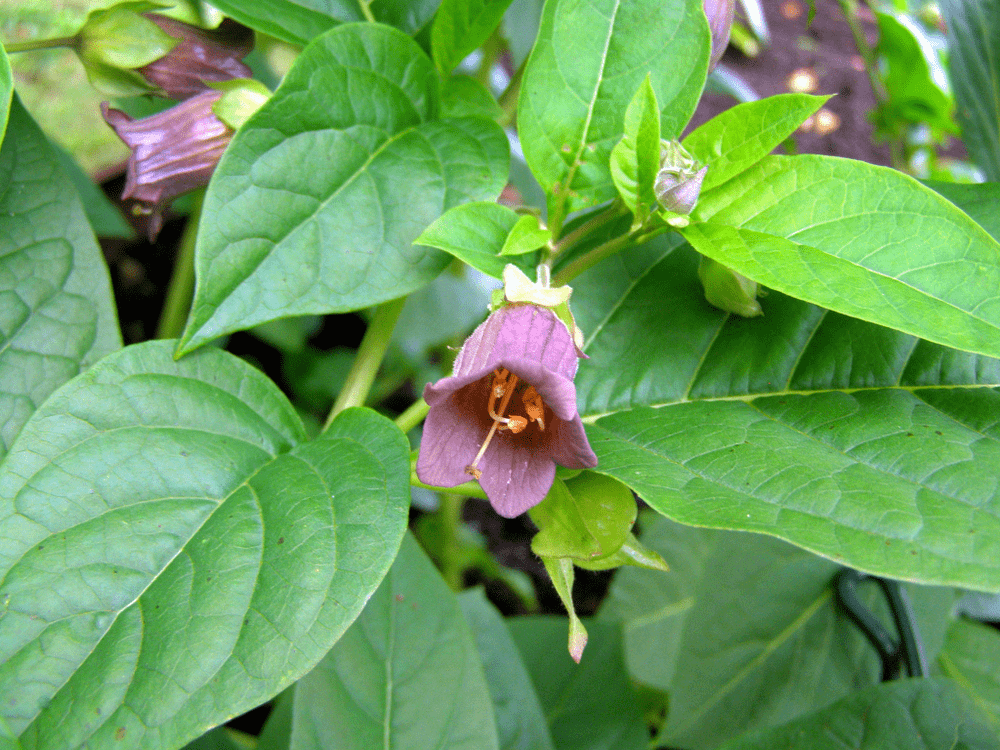Pharmacognosy of Belladonna, Biological source, morphology, microscopy, chemical constituents, uses, adulterants and substitutes of Belladonna
Synonym: Belladonna leaves, Belladonnae folium, Deadly nightshade leaf, European belladonna
Biological source: It consists of dried leaves, flowering tops or other aerial parts of European belladonna Atropa belladonna Linn or Indian belladonna Atropa acuminata Royle. It is also collected in a mixture form of both species when the plants exist in flowering conditions. It contains not less than 0.3 to 0.5 per cent of total alkaloid hyoscyamine.
Traditionally the British pharmacopoeia drug has consisted of all the aerial parts (belladonna herb) but under the European requirement, there is a limit (3%) of the stem with a diameter exceeding 5mm.
Family: Solanaceae
Geographical source: It is indigenous to England and other European countries. It is also found in India (the western Himalayan region from Shimla to Kashmir and Himachal Pradesh). It mainly occurs in the Jammu and Sind forest and the valley of China.
The juice of this plant was used as a cosmetic in olden times due to its dilatory effect on the pupil of the eye.
Cultivation and collection: It was introduced in London pharmacopoeia (1809) but the root was not used in Britain until a liniment was prepared from it.
The Plant of deadly nightshade Atropa belladonna is a perennial herb which attains a height of about 1.5m. The flowers appear at about the beginning of June. They are solitary, shortly stalked, drooping and about 2.5 cm long. A yellow variety of plants lacks anthocyanin pigmentation, the leaves and stem are yellowish green and flowers and berries are yellow in colour.
Belladonna is grown from seed. For this, the berries are crushed to collect seeds. Washing and sieving should be done to obtain good quality seeds which are going to be used for cultivation purposes. The broadcasting method is applied for the sowing of seeds in the well-ploughed field in the month of May to July. The foliar spray of fungicides encourages the growth of plants. The developed seedlings are transplanted in September or October at a certain distance between two plants. The seedlings are carefully irrigated. Fertilizers (Urea, Potash, Superphosphate etc) and insecticides are applied from time to time as per the requirement. The leaves are said to be richest in alkaloidal content at the end of June or July. A sunny position is said to give more active leaves than a shady one. The leaves and flowering parts are cut and dried in the sun or shade dried. During drying care should be taken to retain the green colour of leaves. Plants about 3yr old are sufficiently large to give a good yield of leaves.
If roots are being collected, it would seem to be best to repellant about every third year. Two or more crops of leaves are collected annually. Leaves left in an imperfectly dry state deteriorate and gives an ammonia-like odour. They should therefore be dried immediately after collection and be carefully stored. Good-coloured leaves may be obtained by drying in a thin layer starting with moderate heat which is gradually increased to about 60o C and then gradually decreased.

Morphological characters: The drug consists of a leaf and other smaller stems, the latter seldom exceeding 5mm in diameter, together with flowers and fruits.
Colour:
- Leaf- Greenish or brownish green
- Flowers- Purplish to Yellowish-brown
- Fruits- Greenish to brownish in colour
Odour: Slight and characteristics
Taste: Bitter and acrid
Size: Leaves are 5 − 25 cm × 2.5 − 12 cm, Flower corolla 2.5 cm long and 1.5 cm wide, Fruits about 10 cm in diameter
Shape: Leaves: Ovate, lanceolate to broadly ovate, brittle, Flowers: Campanulate, 5 small reflexed lobes of corolla Fruits: Berries, sub-globular in shape with numerous flat seeds
Chemical constituents: The drug from Atropa belladonna contains 0.3-0.6 per cent alkaloids. The chief alkaloid is Hyoscyamine, small quantities of volatile bases such as pyridine and N-methyl pyrroline are present and if not removed during the assay of the drug by heating, increase the titration and appear in the result as hyoscyamine. The leaf also contains a fluorescent substance, β-methyl esculitine and calcium oxalate. They yield about 14 per cent of ash and not more than 4 per cent of acid-insoluble ash. Roots contain 0.6 per cent, stem 0.05 per cent, leaves 0.4 per cent, unripe and ripe berries 0.19-0.2 per cent and seeds 0.33 per cent alkaloids. The main alkaloids are l-hyoscyamine and its racemic form atropine. The drug also contains belladonna, hyoscine etc.
Dose: 0.6 to 1ml of belladonna tincture 4 times a day.
Adulterant and substitute: The adulteration is mainly done by leaves of Phytolacca americana, Solanum nigrum and Ailanthus glandulosa.
Allied drugs: Indian belladonna from Atropa acuminata, Atropa batrica.
Uses: Belladona leaves are mainly used for internal preparations which use as a sedative and to check secretion. The root preparation is mainly used externally as a parasympatholytic drug whose anticholinergic properties are used to reduce secretion such as sweat, saliva and gastric juice and reduces spasm in intestinal griping due to strong purgative action. It is also used as an antidote for opium and chloral hydrate poisoning.
Pharmacological activity: Atropine and hyoscyamine have the same activity. Atropine acts by competitive and reversible inhibition of acetylcholine binding on its receptor. In the heart and after temporary bradycardia atropine increases the heart rate by suppressing vagal inhibition.
In the blood vessels, the effect on blood pressure is not marked.
Belladonna (fruits, roots, leaves) are toxic. The ingestion of these plants induces a turning red, the mouth and mucosal membranes turn dry and an intense thirst and muscular weakness develop.
The heart rate increases substantially, and mydriasis and hyperthermia are always observed. Hallucination and delirium follow accompanied by agitation sometimes convulsions, sleepiness or comma is next. Recovery takes time (1-3 days). The patient must be monitored and may be treated with charcoal or sedatives.
Make sure you also check our other amazing Article on : Pharmacognosy of Senna
